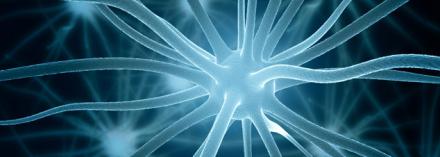
An estimated 1 million Americans have Lewy Body Dementia (LBD), which includes features such as progressive dementia plus varying combinations of fluctuating cognition, visual hallucinations, mood disorders, and autonomic dysfunction. Lewy body dementia is a disease associated with abnormal deposits of a protein called alpha-synuclein in the brain. These deposits, called Lewy bodies, affect chemicals in the brain whose changes, in turn, can lead to problems with thinking, movement, behavior, and mood. Lewy body disease has been discovered to be a common cause for clinical dementia. It encompasses dementia with Lewy bodies (DBL) and Parkinson’s disease dementia (PDD). The generic term “Lewy body dementia” encompasses both entities. Diagnosing LBD can be challenging for a number of reasons. Early LBD symptoms are often confused with similar symptoms found in other brain diseases like Alzheimer’s.
The NINDS supports a number of projects covering all aspects of LBD research. Some of our bigger initiatives are list here:
Biomarkers for the Lewy body dementias
The purpose of the Biomarkers for the Lewy body dementias program is to 1) expand the collection of clinical data and biological specimens in the NINDS Parkinson’s Disease Biomarkers Program (PDBP), a community research resource, to include data from patients with Lewy Body Dementias (including Dementia with Lewy Bodies and Parkinson's Disease with Dementia), and 2) to support hypothesis-driven clinical research to discover biomarkers that will improve the efficiency and outcome of Phase II clinical trials for the Lewy Body dementias and to provide an expansion of this existing research resource center for dissemination of information and access by the scientific community for further advancing research in this field.
Parkinson’s Disease Biomarkers Program
The Parkinson's Disease Biomarkers Program (PDBP) brings together multiple stakeholders dedicated to research and discovery that will advance diagnostic and progression biomarkers for Parkinson's disease and Lewy body dementia. This stakeholder group includes basic and clinical researchers, healthcare professionals, NINDS program staff, information technology experts and most importantly, people with Parkinson's disease and their families and friends.
- More than 1 million individuals in the U.S. have LBD
- Characterized by Lewy bodies – clumps of alpha-synuclein protein – which are a pathological hallmark of Parkinson’s disease
- Problems with thinking, movement, behavior, and sleep
NIH Estimates of Funding for Various Research, Condition, and Disease Categories
| Research/Disease Areas* | FY 2019 (Actual) |
FY 2020 (Actual) |
FY 2021 (Actual) |
FY 2022 Estimated |
|---|---|---|---|---|
| Lewy Body Dementia | $66 | $84 | $93 | $96 |
*Dollars in millions and rounded
To learn more about this NIH Investment, please visit the Categorical Spending site and enter "Lewy Body Dementia".
Proceedings & Outcomes
LBD and the National Plan to Address Alzheimer’s Disease
On January 4, 2011, the National Alzheimer's Project Act (NAPA) was signed into law. The Act defines "Alzheimer's" as Alzheimer's disease and related dementias (AD/ADRD), which includes frontotemporal degeneration (FTD), Lewy body dementia (LBD), vascular contributions to cognitive impairment/dementia (VCID), and mixed etiology dementias (MED).
ADRD 2016 Summit Overview for LBD
The 2016 Alzheimer’s Disease-Related Dementias (ADRD) Summit was hosted by the National Institute of Neurological Disorders and Stroke (NINDS) in collaboration with the National Institute on Aging (NIA). The 2016 ADRD Summit was mandated by the National Plan to address Alzheimer’s Disease as a follow-up to the 2013 ADRD Summit. The Summit set research priorities for LBD research, including:
Establish Longitudinal Diverse Cohorts with Common Measures, Culminating in Autopsy
1. Initiate clinical trials for LBD in diverse populations using therapies that address symptoms that have the greatest impact on patient function and caregiver burden.
2. Create longitudinal clinical, biological, and imaging resources to improve detection and diagnosis of DLB at the pre-dementia or prodromal stage including high risk PD patients.
Discover Disease Mechanisms Through Brain Mapping and Genetics
3. Characterize nervous system changes in LBD cohorts that have come to autopsy to identify disease-specific underlying mechanisms to guide biomarker and therapeutic approaches.
4. Identify novel common and rare genetic variants, epigenetic changes, and environmental influences that impact the risk for and clinical features of LBD.
Develop and Validate Biological and Imaging Biomarkers
5. Develop and validate imaging approaches to enhance the differential diagnostic accuracy of LBD, detect latent and prodromal LBD, and monitor disease progression in natural history and treatment studies.
6. Develop biomarkers for pathologic changes, disease progression, and diagnosis. Incorporate markers for diagnosis of latent or prodromal disease and for monitoring therapeutic responsiveness.
Model Disease Processes to Develop Potential Symptomatic and Disease Modifying Therapies
7. Develop LBD animal, cellular, and in vitro models that recapitulate key features, including clinical pathophysiologic heterogeneity to identify mechanistic candidates for interventions.
8. Develop disease-modifying interventions for LBD based on discovering biomarkers, molecular targets, and genetic and environmental modifiers that enhance, delay or prevent the onset of disease.
Resources and Tools
Contacts
Debra Babcock, Ph.D. | Program Director, Systems and Cognitive Neuroscience
dbabcock@ninds.nih.gov
Beth-Anne Sieber, Ph.D. | Program Director, Neurodegeneration
sieberb@ninds.nih.gov
Funding Opportunities
Alzheimer's Disease and Related Dementias Funding Opportunities
News & Events
A new culprit tangles with ApoE4 in Alzheimer’s disease
Designer compound may untangle damage leading to some dementias
Alzheimer's Association International Conference
Related Topics
Lewy Body Dementia Association: About LBD
